Neil Scheidwasser-Clow
Speaker Embeddings as Individuality Proxy for Voice Stress Detection
Jun 09, 2023



Abstract:Since the mental states of the speaker modulate speech, stress introduced by cognitive or physical loads could be detected in the voice. The existing voice stress detection benchmark has shown that the audio embeddings extracted from the Hybrid BYOL-S self-supervised model perform well. However, the benchmark only evaluates performance separately on each dataset, but does not evaluate performance across the different types of stress and different languages. Moreover, previous studies found strong individual differences in stress susceptibility. This paper presents the design and development of voice stress detection, trained on more than 100 speakers from 9 language groups and five different types of stress. We address individual variabilities in voice stress analysis by adding speaker embeddings to the hybrid BYOL-S features. The proposed method significantly improves voice stress detection performance with an input audio length of only 3-5 seconds.
Efficient Speech Quality Assessment using Self-supervised Framewise Embeddings
Nov 12, 2022
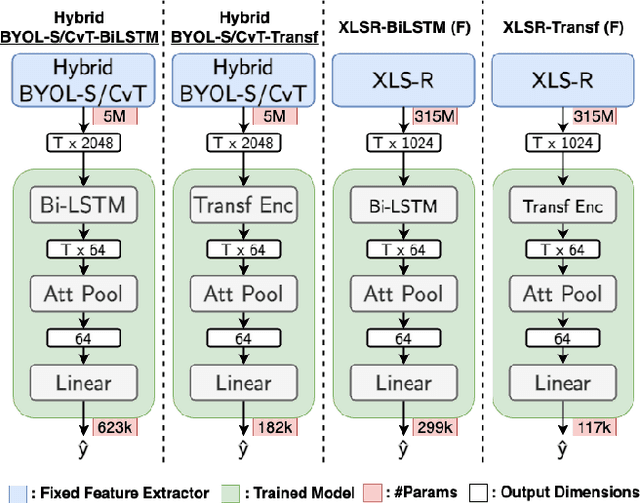
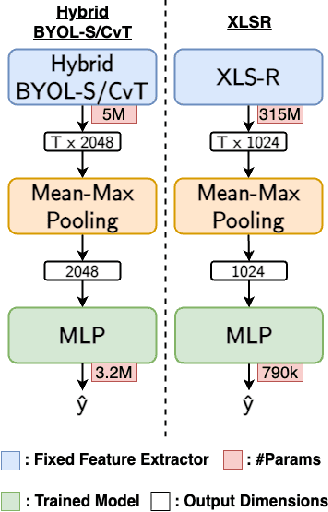
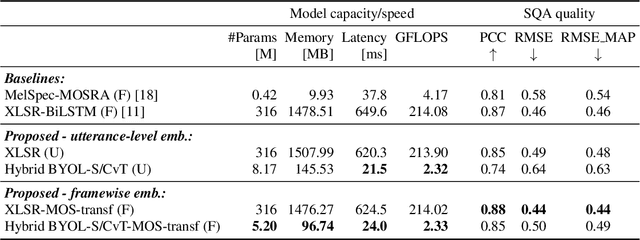
Abstract:Automatic speech quality assessment is essential for audio researchers, developers, speech and language pathologists, and system quality engineers. The current state-of-the-art systems are based on framewise speech features (hand-engineered or learnable) combined with time dependency modeling. This paper proposes an efficient system with results comparable to the best performing model in the ConferencingSpeech 2022 challenge. Our proposed system is characterized by a smaller number of parameters (40-60x), fewer FLOPS (100x), lower memory consumption (10-15x), and lower latency (30x). Speech quality practitioners can therefore iterate much faster, deploy the system on resource-limited hardware, and, overall, the proposed system contributes to sustainable machine learning. The paper also concludes that framewise embeddings outperform utterance-level embeddings and that multi-task training with acoustic conditions modeling does not degrade speech quality prediction while providing better interpretation.
BYOL-S: Learning Self-supervised Speech Representations by Bootstrapping
Jun 30, 2022



Abstract:Methods for extracting audio and speech features have been studied since pioneering work on spectrum analysis decades ago. Recent efforts are guided by the ambition to develop general-purpose audio representations. For example, deep neural networks can extract optimal embeddings if they are trained on large audio datasets. This work extends existing methods based on self-supervised learning by bootstrapping, proposes various encoder architectures, and explores the effects of using different pre-training datasets. Lastly, we present a novel training framework to come up with a hybrid audio representation, which combines handcrafted and data-driven learned audio features. All the proposed representations were evaluated within the HEAR NeurIPS 2021 challenge for auditory scene classification and timestamp detection tasks. Our results indicate that the hybrid model with a convolutional transformer as the encoder yields superior performance in most HEAR challenge tasks.
Hybrid Handcrafted and Learnable Audio Representation for Analysis of Speech Under Cognitive and Physical Load
Mar 30, 2022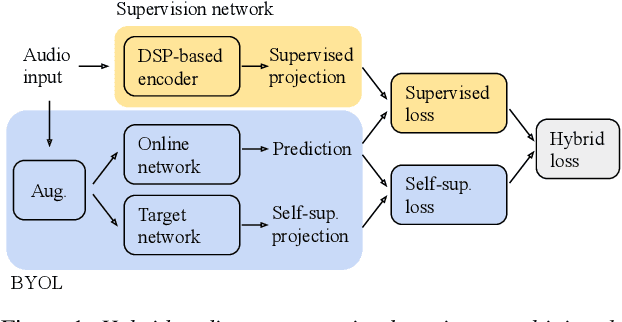

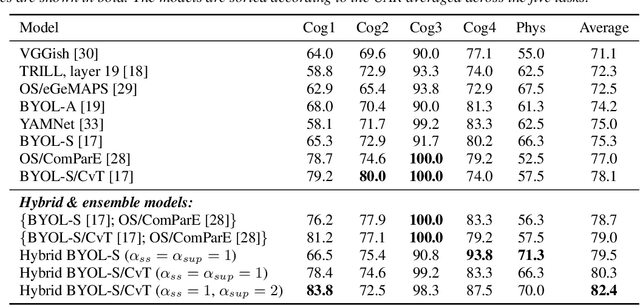
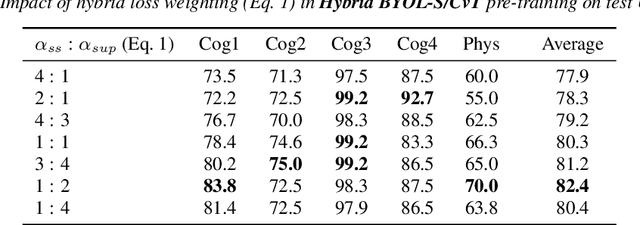
Abstract:As a neurophysiological response to threat or adverse conditions, stress can affect cognition, emotion and behaviour with potentially detrimental effects on health in the case of sustained exposure. Since the affective content of speech is inherently modulated by an individual's physical and mental state, a substantial body of research has been devoted to the study of paralinguistic correlates of stress-inducing task load. Historically, voice stress analysis (VSA) has been conducted using conventional digital signal processing (DSP) techniques. Despite the development of modern methods based on deep neural networks (DNNs), accurately detecting stress in speech remains difficult due to the wide variety of stressors and considerable variability in the individual stress perception. To that end, we introduce a set of five datasets for task load detection in speech. The voice recordings were collected as either cognitive or physical stress was induced in the cohort of volunteers, with a cumulative number of more than a hundred speakers. We used the datasets to design and evaluate a novel self-supervised audio representation that leverages the effectiveness of handcrafted features (DSP-based) and the complexity of data-driven DNN representations. Notably, the proposed approach outperformed both extensive handcrafted feature sets and novel DNN-based audio representation learning approaches.
SERAB: A multi-lingual benchmark for speech emotion recognition
Oct 07, 2021
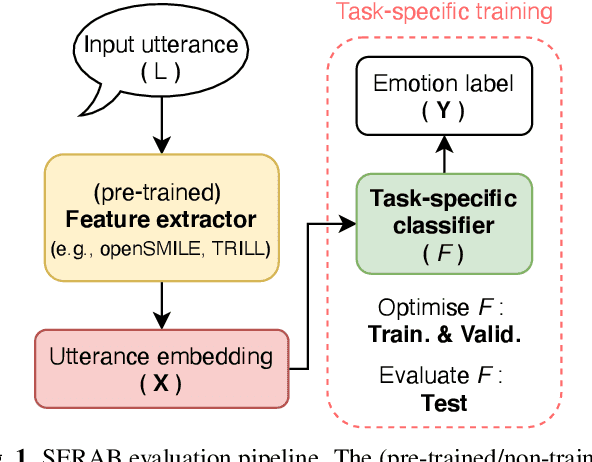
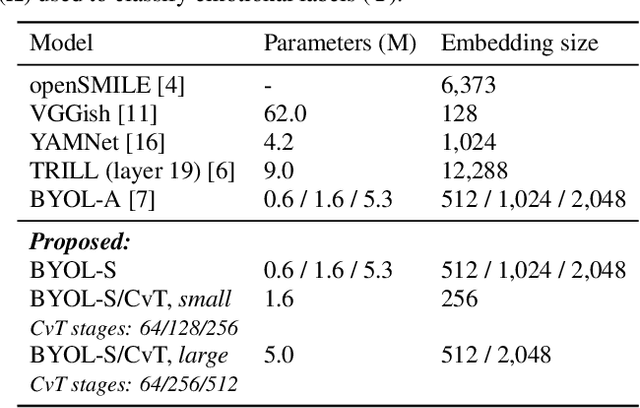
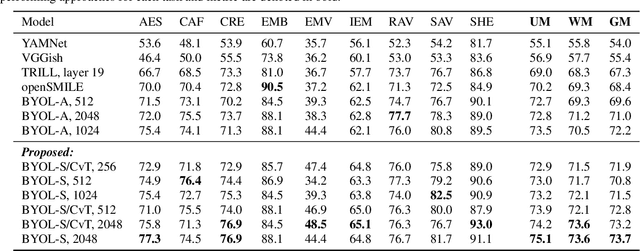
Abstract:Recent developments in speech emotion recognition (SER) often leverage deep neural networks (DNNs). Comparing and benchmarking different DNN models can often be tedious due to the use of different datasets and evaluation protocols. To facilitate the process, here, we present the Speech Emotion Recognition Adaptation Benchmark (SERAB), a framework for evaluating the performance and generalization capacity of different approaches for utterance-level SER. The benchmark is composed of nine datasets for SER in six languages. Since the datasets have different sizes and numbers of emotional classes, the proposed setup is particularly suitable for estimating the generalization capacity of pre-trained DNN-based feature extractors. We used the proposed framework to evaluate a selection of standard hand-crafted feature sets and state-of-the-art DNN representations. The results highlight that using only a subset of the data included in SERAB can result in biased evaluation, while compliance with the proposed protocol can circumvent this issue.
 Add to Chrome
Add to Chrome Add to Firefox
Add to Firefox Add to Edge
Add to Edge